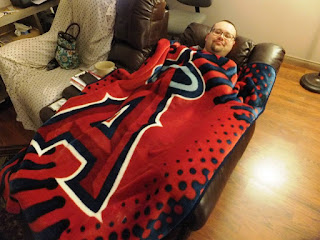Welcome to National Family Caregivers Month. What is a caregiver? Basically, if you're someone with special needs necessary for living a normal life, you will need someone to help you meet those needs. That is a caregiver (also called a carer in some parts of the world).
While our blog focuses on disabilities, particularly mobility deficiencies, most of it is written by a caregiver with input by the one cared for (for the perspective of the person being cared for, you can check out Tim's series of posts called Cerebral Palsy Stories).
During this month, we'll be posting some articles about caregiving, what it is, how to do it, and how to pay for it. Our focus will be on persons needing help due to mobility issues.
How, exactly, does this caring get done? What does it entail?
I'll be relying a bit on Tim's posts for some of this explanation but here is a typical day.
7:30am (8:00am on weekends)- I open Tim's bedroom door, raise his curtains, and remove his CPAP machine (Tim has sleep apnea to go with his other disabilities). I give him ten minutes to "work up a feeling" as he puts it, the feeling to go to the bathroom.
7:40am - I transfer Tim from his bed to his commode chair. I position the commode chair near his bed, swing his legs over the side, and stand him up. He is able to support his weigh on his legs while I swing him to the chair. A quick lift gets him onto the seat.
(We use a Drive Commode wheelchair, which is almost an exact copy of the Aquatec Commode chair but about half the price. It works very well for us - Ed)
I wheel him into the bathroom, positioned over the toilet to do his business, then leave him there until he's finished (see Tim's post about answering the call of nature for more information).
When he's finished, I have to clean him up. Yeah, it's about as fun as you think it is.
(You'll probably want to have some disposable gloves, good toilet paper, and wipes on hand for this.- Ed)
I wash up then wheel him a couple of feet into the shower. Tim has a roll-in shower and a shower head on a hose to make things easier. I give him a shave and a shower (see Tim's post on taking a shower to see how it's done).
When shower's over, I dry him off, apply a little medicine to help prevent pressure sores (skin lesions on his behind that can develop from constantly sitting) and wheel him over to his room.
A little deodorant and then I get him dressed, including putting ankle foot orthotics on him (AFOs) to help position his ankles. These are commonly called braces.
Once he's dressed, I'll help him stand for four minutes, putting weight on his legs, for therapy. Then I'll transfer him over to his wheelchair, which has been charging overnight.
Once done, I'll give him his morning medication and send him over to his mom who will install his tray and he'll eat the breakfast I've prepared for him and watch TV. Tim's not a big breakfast eater so his meal consists of pieces of fresh fruit that he can feed himself.
Twice a week, at mid morning, Tim and I will do a workout together which includes weight training with resistance bands. Otherwise, he's done until lunch except for another bathroom break, mid-morning.
(We use Veick Resistance bands for our workout.-Ed)
Lunchtime is usually around 11:30-12 noon. I'll prepare a lunch, or maybe buy a sandwich at our local deli, and feed it to him. When that's done, I'll floss and brush his teeth and help him go to the bathroom.
(Tim's toothbrush is a Collis Curve which is very handy for brushing someone else's teeth. -Ed)
When that's done, I can eat my lunch and he'll be good for most of the afternoon except he may have to go to the bathroom again, take his midday pill, and want his water glass refilled.
Either my wife or I will prepare dinner for all of us or go out to eat. At home, I usually feed Tim dinner. When we go out, it's usually my wife. Either way, after dinner one of us brushes his teeth again and I help him go to the bathroom.
After we're done, I'll transfer him to a recliner where he can relax and watch TV until bedtime.
At bedtime, I'll transfer him back into his wheelchair, give him is nighttime medication, help him go to the bathroom, and put him in the bed. My wife will set him up with the CPAP machine and make sure he's covered.
That's the end of our day but we'll sleep with a monitor in case he needs something in the middle of the night. Most of the time, he doesn't but once in awhile something will come up.
Darryl Musick
Copyright 2021 - All Rights Reserved








No comments:
Post a Comment